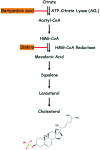New and emerging lipid-modifying drugs to lower LDL cholesterol
- PMID: 34795777
- PMCID: PMC8565402
- DOI: 10.7573/dic.2021-8-3
New and emerging lipid-modifying drugs to lower LDL cholesterol
Abstract
Cardiovascular disease (CVD) represents the leading cause of death worldwide. The role of low-density lipoprotein-cholesterol (LDL-C) in the pathophysiology of atherosclerosis and CVD has been well recognized. Statins are the standard of care for the management of hypercholesterolaemia, and their effectiveness in lowering LDL-C and reducing CVD risk in both primary and secondary prevention has been well established. However, several patients fail to attain optimal LDL-C goals or are intolerant to statins, especially at high doses. PCSK9 inhibitors, bempedoic acid, inclisiran, ANGPTL3 inhibitors, PPARβ/δ agonists and LXR agonists are novel or upcoming LDL-C-lowering agents that have shown promising beneficial results. This review aims to present and discuss the current clinical and scientific data pertaining to the new and emerging lipid-modifying LDL-C-lowering drugs.
Keywords: ANGPTL3 inhibitors; LDL-C-lowering; LXR agonists; PCSK9 inhibitors; PPARβ/δ agonists; bempedoic acid; cardiovascular disease; inclisiran.
Copyright © 2021 Kosmas CE, Pantou D, Sourlas A, Papakonstantinou EJ, Echavarria Uceta R, Guzman E.
Conflict of interest statement
Disclosure and potential conflicts of interest: Constantine E. Kosmas and Eliscer Guzman have served as members of the Dyslipidemia Speaker Bureau of Amgen, Inc. The International Committee of Medical Journal Editors (ICMJE) Potential Conflicts of Interests form for the authors is available for download at: https://www.drugsincontext.com/wp-content/uploads/2021/10/dic.2021-8-3-COI.pdf
Figures



References
-
- GBD 2017 Causes of Death Collaborators. Global, regional, and national age-sex-specific mortality for 282 causes of death in 195 countries and territories, 1980–2017: a systematic analysis for the Global Burden of Disease Study 2017. Lancet. 2018;392(10159):1736–1788. doi: 10.1016/S0140-6736(18)32203-7. - DOI - PMC - PubMed
-
- Cholesterol Treatment Trialists’ (CTT) Collaboration. Baigent C, Blackwell L, et al. Efficacy and safety of more intensive lowering of LDL cholesterol: a meta-analysis of data from 170,000 participants in 26 randomised trials. Lancet. 2010;376(9753):1670–1681. doi: 10.1016/S0140-6736(10)61350-5. - DOI - PMC - PubMed
Publication types
LinkOut - more resources
Full Text Sources
Miscellaneous

